
In geology and mineralogy, a mineral or mineral species is, broadly speaking, a solid substance with a fairly well-defined chemical composition and a specific crystal structure that occurs naturally in pure form.

Titanite, or sphene (from Ancient Greek σφηνώ (sphēnṓ) 'wedge'), is a calcium titanium nesosilicate mineral, CaTiSiO5. Trace impurities of iron and aluminium are typically present. Also commonly present are rare earth metals including cerium and yttrium; calcium may be partly replaced by thorium.

Topaz is a silicate mineral made of aluminum and fluorine with the chemical formula Al2SiO4(F, OH)2. It is used as a gemstone in jewelry and other adornments. Common topaz in its natural state is colorless, though trace element impurities can make it pale blue or golden brown to yellow-orange. Topaz is often treated with heat or radiation to make it a deep blue, reddish-orange, pale green, pink, or purple.

Plagioclase ( PLAJ-(ee)-ə-klayss, PLAYJ-, -klayz) is a series of tectosilicate (framework silicate) minerals within the feldspar group. Rather than referring to a particular mineral with a specific chemical composition, plagioclase is a continuous solid solution series, more properly known as the plagioclase feldspar series. This was first shown by the German mineralogist Johann Friedrich Christian Hessel (1796–1872) in 1826. The series ranges from albite to anorthite endmembers (with respective compositions NaAlSi3O8 to CaAl2Si2O8), where sodium and calcium atoms can substitute for each other in the mineral's crystal lattice structure. Plagioclase in hand samples is often identified by its polysynthetic crystal twinning or "record-groove" effect.

Amphibole is a group of inosilicate minerals, forming prism or needlelike crystals, composed of double chain SiO
4 tetrahedra, linked at the vertices and generally containing ions of iron and/or magnesium in their structures. Its IMA symbol is Amp. Amphiboles can be green, black, colorless, white, yellow, blue, or brown. The International Mineralogical Association currently classifies amphiboles as a mineral supergroup, within which are two groups and several subgroups.

Pleochroism is an optical phenomenon in which a substance has different colors when observed at different angles, especially with polarized light.

Vanadinite is a mineral belonging to the apatite group of phosphates, with the chemical formula Pb5(VO4)3Cl. It is one of the main industrial ores of the metal vanadium and a minor source of lead. A dense, brittle mineral, it is usually found in the form of red hexagonal crystals. It is an uncommon mineral, formed by the oxidation of lead ore deposits such as galena. First discovered in 1801 in Mexico, vanadinite deposits have since been unearthed in South America, Europe, Africa, and North America.
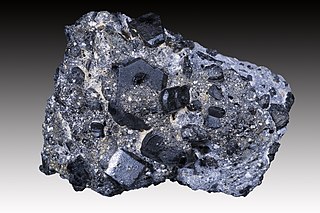
Augite, also known as Augurite, is a common rock-forming pyroxene mineral with formula (Ca,Na)(Mg,Fe,Al,Ti)(Si,Al)2O6. The crystals are monoclinic and prismatic. Augite has two prominent cleavages, meeting at angles near 90 degrees.

Rhodochrosite is a manganese carbonate mineral with chemical composition MnCO3. In its pure form (rare), it is typically a rose-red colour, but it can also be shades of pink to pale brown. It streaks white, and its Mohs hardness varies between 3.5 and 4.5. Its specific gravity is between 3.45 and 3.6. The crystal system of rhodochrosite is trigonal, with a structure and cleavage in the carbonate rhombohedral system. The carbonate ions (CO2−
3) are arranged in a triangular planar configuration, and the manganese ions (Mn2+) are surrounded by six oxygen ions in an octahedral arrangement. The MnO6 octahedra and CO3 triangles are linked together to form a three-dimensional structure. Crystal twinning is often present. It can be confused with the manganese silicate rhodonite, but is distinctly softer. Rhodochrosite is formed by the oxidation of manganese ore, and is found in South Africa, China, and the Americas. It is one of the national symbols of Argentina.

Cassiterite is a tin oxide mineral, SnO2. It is generally opaque, but it is translucent in thin crystals. Its luster and multiple crystal faces produce a desirable gem. Cassiterite was the chief tin ore throughout ancient history and remains the most important source of tin today.

Scheelite is a calcium tungstate mineral with the chemical formula CaWO4. It is an important ore of tungsten (wolfram). Scheelite is originally named after Swedish chemist Carl Wilhelm Scheele (1742–1786). Well-formed crystals are sought by collectors and are occasionally fashioned into gemstones when suitably free of flaws. Scheelite has been synthesized using the Czochralski process; the material produced may be used to imitate diamond, as a scintillator, or as a solid-state lasing medium. It was also used in radium paint in the same fashion as was zinc sulphide, and Thomas Edison invented a fluoroscope with a calcium tungstate-coated screen, making the images six times brighter than those with barium platinocyanide; the latter chemical allowed Röntgen to discover X-rays in early November 1895. Note, the semi-precious stone marketed as 'blue scheelite' is actually a rock type consisting mostly of calcite and dolomite, with occasional traces of yellow-orange scheelite.

Euclase is a beryllium aluminium hydroxide silicate mineral (BeAlSiO4(OH)). It crystallizes in the monoclinic crystal system and is typically massive to fibrous as well as in slender prismatic crystals. It is related to beryl (Be3Al2Si6O18) and other beryllium minerals. It is a product of the decomposition of beryl in pegmatites.
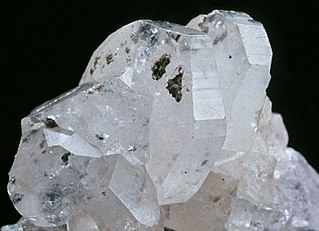
Phenakite or phenacite is a fairly rare nesosilicate mineral consisting of beryllium orthosilicate, Be2SiO4. Occasionally used as a gemstone, phenakite occurs as isolated crystals, which are rhombohedral with parallel-faced hemihedrism, and are either lenticular or prismatic in habit: the lenticular habit is determined by the development of faces of several obtuse rhombohedra and the absence of prism faces. There is no cleavage, and the fracture is conchoidal. The Mohs hardness is high, being 7.5–8; the specific gravity is 2.96. The crystals are sometimes perfectly colorless and transparent, but more often they are greyish or yellowish and only translucent; occasionally they are pale rose-red. In general appearance the mineral is not unlike quartz, for which indeed it has been mistaken. Its name comes from Ancient Greek: φέναξ, romanized: phénax, meaning "deceiver" due to its close visual similarity to quartz, named by Nils Gustaf Nordenskiöld in 1833.

Datolite is a calcium boron hydroxide nesosilicate, CaBSiO4(OH). It was first observed by Jens Esmark in 1806, and named by him from δατεῖσθαι, "to divide," and λίθος, "stone," in allusion to the granular structure of the massive mineral.

Heulandite is the name of a series of tecto-silicate minerals of the zeolite group. Prior to 1997, heulandite was recognized as a mineral species, but a reclassification in 1997 by the International Mineralogical Association changed it to a series name, with the mineral species being named:
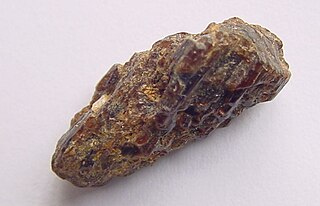
Painite is a very rare borate mineral. It was first found in Myanmar by British mineralogist and gem dealer Arthur C.D. Pain who misidentified it as ruby, until it was discovered as a new gemstone in the 1950s. When it was confirmed as a new mineral species, the mineral was named after him. Due to its rarity, painite can cost between US$50,000 to $60,000 per carat.
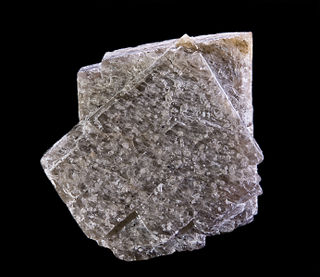
Sanidine is the high temperature form of potassium feldspar with a general formula K(AlSi3O8). Sanidine is found most typically in felsic volcanic rocks such as obsidian, rhyolite and trachyte. Sanidine crystallizes in the monoclinic crystal system. Orthoclase is a monoclinic polymorph stable at lower temperatures. At yet lower temperatures, microcline, a triclinic polymorph of potassium feldspar, is stable.
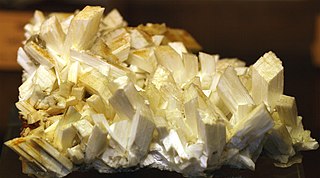
Laumontite is a mineral, one of the zeolite group. Its molecular formula is Ca(AlSi2O6)2 · 4H2O, a hydrated calcium-aluminium silicate. Potassium or sodium may substitute for the calcium but only in very small amounts.
Geigerite is a mineral, a complex hydrous manganese arsenate with formula: Mn5(AsO3OH)2(AsO4)2·10H2O. It forms triclinic pinacoidal, vitreous, colorless to red to brown crystals. It has a Mohs hardness of 3 and a specific gravity of 3.05.
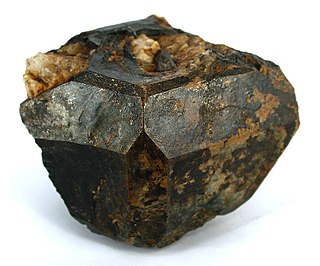
Microlite was once known as a pale-yellow, reddish-brown, or black isometric mineral composed of sodium calcium tantalum oxide with a small amount of fluorine. Its chemical formula is (Na,Ca)2Ta2O6(O,OH,F). Today it is a name of a group of oxide minerals of a similar stoichiometry having tantalum prevailing over titanium and niobium. The microlite group belongs to a large pyrochlore supergroup that occurs in pegmatites and constitutes an ore of tantalum. It has a Mohs hardness of 5.5 and a variable specific gravity of 4.2 to 6.4. It occurs as disseminated microscopic subtranslucent to opaque octahedral crystals with a refractive index of 2.0 to 2.2. Microlite is also called djalmaite, but both names are now obsolete.
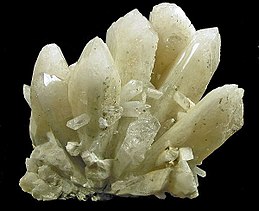
![Danburite from Mexico, [?] 4 cm in height Danburite 2581.jpg](http://upload.wikimedia.org/wikipedia/commons/thumb/5/55/Danburite_2581.jpg/100px-Danburite_2581.jpg)


















